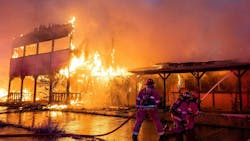OSHA’s Move to Improve Safety to Firefighters, EMS Providers, and Technical Search and Rescue Members
The current Occupational Safety and Health Administration (OSHA) Fire Brigades standard (1910.156) outlines the baseline requirements for fire brigades in workplaces and covers a variety of topics to include organization, training, equipment and operations, to ensure firefighting activities are safe in the workplace. The new proposed standard, which is titled Emergency Response, focuses on doing what OSHA was established to do: protect workers. If adopted, the new standard will advance regulation nearly 40 years and encompass new research and many consensus documents that focus on improving best practices and reporting of the real-world hazards that firefighters, EMS personnel and technical rescue members face each day.
OSHA’s mission
As it applies to the fire service, most people might believe that OSHA is a regulatory agency that issues large fines for violations that it finds when it visits a department. Although that might be true, the agency’s true focus is to ensure safe and healthy working conditions, both physical and mental, for workers. Every day, the employees of OSHA endeavor to prevent work-related injuries, illnesses and fatalities. Sound familiar? It sets standards, enforces regulation, trains and uses data to find commonalities to focus on. OSHA’s fines are large, because workers have the right to work in safe work environments and then go home. Sound familiar again?
OSHA vs. NFPA data
OSHA has worked on the new proposed standard since the terrorist attacks on 9/11, after all government agencies, including OSHA, were directed to strengthen their preparedness to respond to terrorist attacks, major disasters and other emergencies. Since then, OSHA identified many gaps in the protections for emergency responders and disaster recovery workers. It published several requests for information (RFI) to gain feedback on 1910.156 and determined that there was enough interest to move forward with a subcommittee of career and volunteer emergency response experts to develop a new standard that better protects firefighters, EMS providers, and technical search and rescue personnel.
OSHA began to collect data to research trends on fatalities, injuries and illnesses and quickly learned that its data weren’t consistent with the NFPA dataset. For example, NFPA showed that there were 72.4 fatalities between 2007–2021, where the OSHA Information System showed 18.2 fatalities in the time period. The assigned task at death is different in all areas, too. OSHA concluded not only that the NFPA dataset and the OSHA Information System dataset were different but also focused on different details. NFPA focuses primarily on firefighters; OSHA focuses on all emergency responders who are determined to fall under the scope of rule. OSHA reviewed 273 fatalities and identified hazards that include incorrect use of PPE; lack of standard operating procedures; inadequate operation and training while using a vehicle; failure to adhere to best practices in immediately dangerous to life and health (IDLH) situations; failure to meet medical evaluation requirements; lack of an effective emergency response plan and/or risk management plan; and failure to meet the minimum training requirements.
OSHA also reviewed nonfatal injuries and found emergency response personnel (fire and EMS) are “at a higher risk of injury than the general public,” with the most common injury being overexertion or strain. This result was identified both on scene and during training. (I wasn’t surprised to see how many injuries occur during training.)
In a nutshell, we have continued to see the same hazards and practices hurting emergency responders for decades. As Benjamin Franklin stated, “An ounce of prevention is worth a pound of cure.”
Proposed standard & states
If adopted, the new proposed standard will broaden the range of hazards that emergency responders face and incorporate numerous consensus standards that were issued by NFPA. OSHA will align the standard to work with the Department of Homeland Security’s National Incident Management System (NIMS). The standard will apply broadly and through state-regulated, OSHA-approved plans to include Alaska, Arizona, California, Hawaii, Indiana, Iowa, Kentucky, Maryland, Michigan, Minnesota, Nevada, New Mexico, North Carolina, Oregon, South Carolina, Tennessee, Utah, Vermont, Virginia, Washington and Wyoming. Each of these states developed and implemented its own occupational safety and health program that must be at least as effective as OSHA standards. The new proposed standard also may cover nonprofit agencies, tribal entities that have public facilities, and private entities that have fire brigades and technical rescue teams.
The new proposed standard won’t apply to volunteers. States that have their own plan may treat volunteers differently. Each state will have to look at its definition of a volunteer and determine whether the definition meets the true definition under the IRS employee vs. volunteer measure. If volunteers receive any kind of hourly remuneration, it’s likely that the new proposed standard will apply to them. This proposal should demand your attention.
Economics
In addition to the traumatic injuries that emergency personnel face, OSHA is looking at the immediate and long-term health effect on emergency response activities.
Because members of the fire service are exposed to combustible products, hazardous materials and substances, and infectious diseases, they face acute and chronic health conditions as well as behavioral health issues and workplace violence. Furthermore, the fire service’s mission has grown, and its capabilities have improved, which increases risk to the workforce.
Also, multiple studies identified contaminants that are inside of fire stations on firefighter gear and equipment that might expose firefighters on a regular basis with little awareness. Most of the fire stations across the United States are outdated, and departments are modifying stations to fit their new apparatus. The stations aren’t designed to mitigate exposure and aren’t returning fresh air into the fire station consistently.
From an OSHA perspective, emergency response personnel are being exposed to hazardous substances inside the workplace. All of this information, along with the federal directive, has driven the new proposed standard to improve the health and safety of members.
While reading through the document, I counted 44 NFPA standards that the committee reviewed. Although some of those standards will be incorporated into another standard, there are at least 30 NFPA standards that might be incorporated by reference into the new proposed standard. This is when the hair on the back of my head started to tingle. If the standard refers to one of these NFPA documents, the NFPA standard becomes something that we must do by law. That can become very challenging for many departments to accomplish. Even though the committee conducted an economic analysis on how the new proposed standard will affect emergency response agencies, the members of the committee appear to not fully understand that most response teams hold special events to pay for fuel and equipment.
Get involved now
My other thought makes me wonder whether the new proposed standard, if it does in fact pass, will become the “best practice” for all states?
We often refer to NFPA standards as a guideline to make small improvements, but many of them soon could become law. What is the cost of implementing and managing all of this? Would it change your staffing model, equipment needs and budget? There are many questions that all of you should consider for your department’s operation.
The areas of focus are on training and certification, personal protective gear, health and safety programs, reporting, medical evaluation and surveillance, and incident command. The new proposed standard refers to establishing pre-incident plans. At minimum, it will require a department to place its personnel in tiers based on their level of training; develop identifiable hazard zones on scene; identify the types and level of services that a department provides; develop a vulnerability assessment; identify minimum staffing needs; ensure at least “four team members or responders are assembled before initiating in an IDLH atmosphere”; establish procedures for a mayday; conduct a post-incident analysis.
It’s important for all who might be affected by the new proposed standard to get involved now. There are several taped discussions on the topic, and your comments to OSHA on how this will affect you are very important. Once the new proposed standard is made into law, it will be very difficult to change.
The primary effort of the new proposed standard is to improve employee and workplace safety. I get it, and I commend the committee for wanting to improve the wellness and safety of emergency responders. However, it’s very complex and needs more time for both the public and private sector to digest. The public comment period runs until June 21, 2024.
About the Author

Jerry Streich
Jerry Streich is an organizational development practitioner who has 37 years of experience in fire service recruitment, retention, strategic planning and station design. He has led local, regional and statewide recruitment initiatives, managed multi-million-dollar grants, and spearheaded department reorganizations and new fire department formations. As the owner of one of the nation’s largest firefighter recruitment websites, Streich continues to develop innovative staffing solutions through his firm, Capstone LLC.
